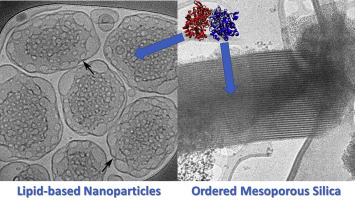Current Opinion in Colloid & Interface Science ( IF 8.9 ) Pub Date : 2019-10-11 , DOI: 10.1016/j.cocis.2019.09.007 Maria Valldeperas , Andrea Salis , Justas Barauskas , Fredrik Tiberg , Thomas Arnebrant , Valdemaras Razumas , Maura Monduzzi , Tommy Nylander

|
Enzymes have come into use for many new applications outside their natural biological environment, taking advantage of their high efficiency and selectivity as biocatalysts. Such new application often requires encapsulation to preserve the structure and activity of the enzyme, but also regulate and control the activity. We will here discuss two types of encapsulation, soft matrices consisting of polar lipid liquid crystals and hard ordered mesoporous silica matrices. For both types of matrices, the challenge is to control the pore size of the matrices as well as the interaction with the matrix interface. Here the polar lipid liquid crystals offer larger flexibility than the silica, but on the other hand it is considerably more sensitive to environment.
中文翻译:

酶封装在纳米结构的自组装结构中-朝向生物功能超分子组装体
利用酶的高效率和选择性作为生物催化剂,酶已在其自然生物环境以外的许多新应用中使用。这种新的应用通常需要封装以保持酶的结构和活性,而且还调节和控制该活性。在这里,我们将讨论两种类型的封装:由极性脂质液晶组成的软基质和有序介孔二氧化硅基质。对于两种类型的基质,挑战在于控制基质的孔径以及与基质界面的相互作用。在这里,极性脂质液晶提供了比二氧化硅更大的柔韧性,但另一方面,它对环境更加敏感。



























 京公网安备 11010802027423号
京公网安备 11010802027423号